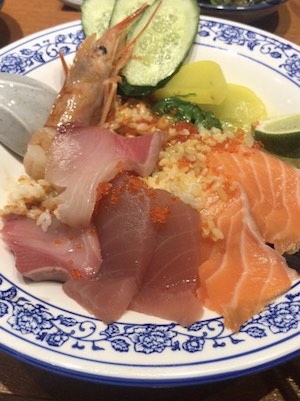

It ranges from lean to fattier pieces, with salmon belly coming at a premium price due to its extra fattiness. Salmon is easily recognized for its bright orange color. Katsuo is one of the most popular kinds of tuna in Japan, and one of the most popular ways to eat it is “ katsu no tataki” style, lightly seared on the outside and raw the inside, served thinly sliced with ponzu citrus and garlic or ginger. Popular Types of Sashimi Katsuo (Bonito / Skipjack Tuna) When eating sashimi, be sure to use chopsticks, and take care not overload each piece with condiments, which overpowers the flavor of the fish. For condiments, soy sauce and grated wasabi horseradish are usually provided, and sometimes ponzu, a citrus-y soy sauce, may also be offered.

Sashimi is typically served on a platter or on ice with some sort of garnish, including shredded daikon radish, shiso perilla herb, kogiku chrysanthemum flower, benitade (red water pepper sprouts), and sometimes even accompanied by the head and tails of the fish that the sashimi was cut from, or the shells that the shellfish was taken from. Sashimi can be eaten as a standalone treat with some beer or sake, or as part of a larger course meal. Sashimi is made by cutting the ingredients into bite-sized rectangular shapes, thin diagonal slices, small firm squares, or thin julienned slivers.

While sashimi can refer to almost any kind of meat-including raw beef, chicken, and even horse-fish and seafood are the most popular items to be eaten this way. The name “sashimi” literally means “cut body” in Japanese, but it uses the kanji character for “pierce” rather than “cut” as the kanji for “cut” was considered an auspicious term reserved for samurai. The practice of eating raw fish first arrived to Japan via China around 500 BCE, and since then it’s become an integral part of the Japanese diet. Sashimi, or eating raw thinly sliced food, is a traditional form of dining in Japan that goes back thousands of years.


 0 kommentar(er)
0 kommentar(er)
